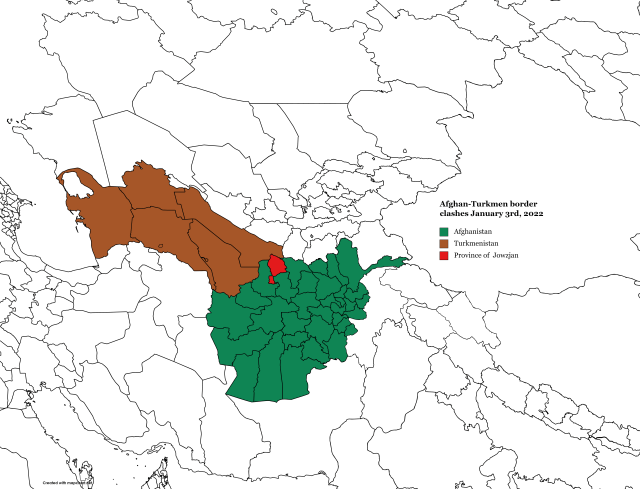
The recent border clashes between the Taliban and Turkmen security forces highlight how fragile the security situation is in the region. As a matter of fact, in the last month, the Taliban also collided with the Iranian and Pakistani border guards.
On January 3rd, 2021, the Afghan media reported clashes between Turkmen border guards and the Taliban at the Afghanistan-Turkmenistan border. According to the Afghan agency TOLO News and Hasht-e subh, citing local authorities, the incident took place in the Khamab district of the northern province of Jowzjan.
Commenting on this episode, Helal Balkhi, acting head of the Taliban Information and Culture Department in Jowzjan province, citing local witnesses, said that on December 29th, 2021, Turkmen border guards allegedly killed an ethnic Turkmen civilian called Abdulkerim and beat another. Consequently, when representatives of the Taliban arrived at the scene to investigate the incident, they had a conflict with the Turkmen forces, which escalated into a shootout. According to official statements, the Taliban did not register any casualties.
While the Taliban provided their version of the episode and confirmed no casualties, the Turkmen Government did not comment on the clashes between its forces and the Taliban.
This is not the first time that the Taliban clashed with foreign border guards considering that the Taliban were involved in conflict and clashes at the Iranian-Afghan and Pakistani-Afghan borders in the last month.
On January 2nd, 2022, Pakistani forces clashed with the Taliban over fencing at the Durand Line. Two days before, on December 31st, 2021, four Pakistani soldiers died during an operation to capture a Pakistani Taliban who was hiding in the town of Mir Ali in the North Waziristan border district.
On December 1st, 2021, Iranian media reported that Taliban forces opened fire on Iranian farmers, thinking they violated the border, leading Iranian soldiers to intervene. The consequent clashes between the two parties did not lead to any casualties, and both Tehran and Kabul ascribed the episode as a ‘misunderstanding’.
This episode confirms that the borders among Afghanistan and neighbouring countries might become zones of clashes or conflicts. On the one hand, Central Asian governments are interested in preserving border security and extending their area of control and influence inside Afghanistan to prevent any possible enemy infiltration by terrorist groups operating on Afghan soil. On the other hand, the Taliban are trying to maintain their power and control on the border areas showing to the Afghan people and foreign countries that they can control the situation in the country. In the case of Pakistan, since the Durand Line has always been a matter of confrontation between Kabul and Islamabad, the Taliban might even push farther their borders inside the Pakistani territory claiming those areas as part of Afghanistan because the Pashtun tribes inhabited there.
The fact that the Turkmen government has not yet commented on the clash at the border might depend on Ashgabat’s necessity to keep solid relations with Kabul to finally realise the TAPI gas pipeline upon which hugely rely Turkmen energy export toward the eastern markets (Gasdotto TAPI tra speranze future e interessi geopolitici, Geopolitical Report ISSN 2785-2598 Volume 5 Issue 2).



